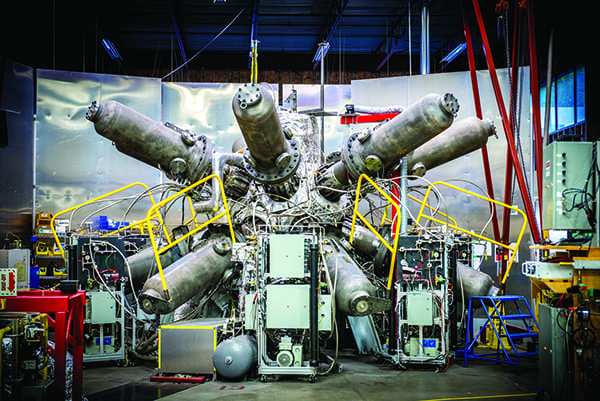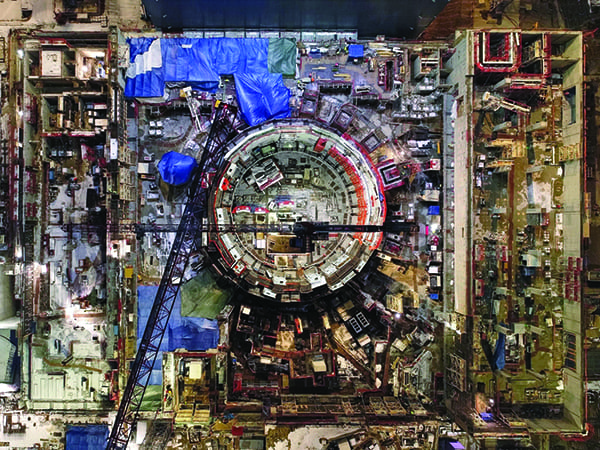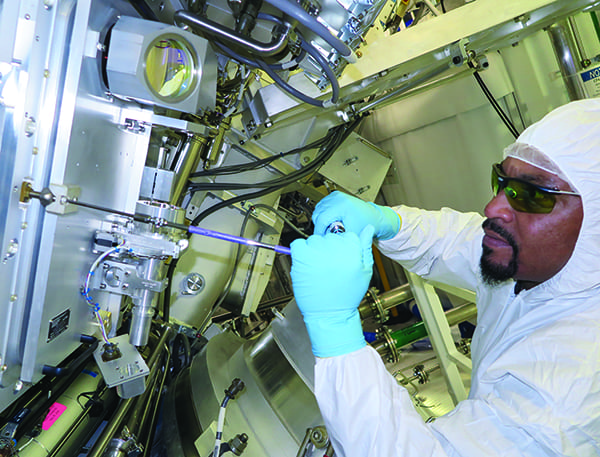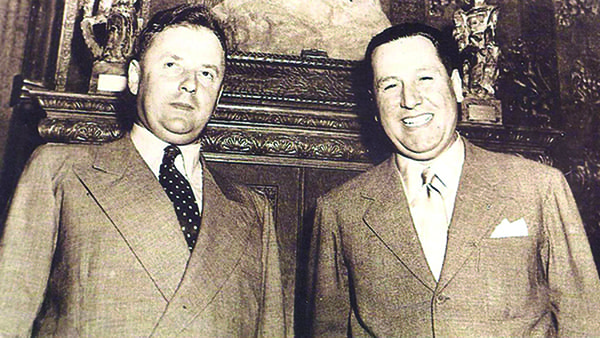Fusion Power: Watching, Waiting, as Research Continues
Cheap and abundant electric power from nuclear fusion-power "too cheap to meter"-has been a dream for more than a half-century. But as time passes, practical fusion appears to be moving further into the future, prompting some skeptics to proclaim it the "forever fuel."
For more than 60 years producing electric power from nuclear fusion-smashing hydrogen atoms together with enormous force to form helium atoms and release vast amounts of energy as a low-cost and endless fuel supply-has been a holy grail of energy gurus. Governments worldwide have spent hundreds of billions of dollars, perhaps more than a trillion, in pursuit of that glittering, elusive goal.
All that effort and all those resources have so far produced few practical results and nothing approaching a commercial generating technology. When the U.S. government first announced a coordinated fusion research and development (R&D) program at the Atomic Energy Commission (AEC) in the 1950s, the AEC said commercial fusion energy was 25 years in the future. In a 1969 speech, then-AEC Chairman Glenn Seaborg said that "with the successful use of controlled fusion, man will have a virtually unlimited energy resource at hand. Even at a power consumption rate many times that of today, he will have an energy reserve that will last for millions of years."
Today, more than six decades after the AEC's fusion R&D program began, optimistic projections suggest fusion energy will be practical no sooner than 2050. In 2006, New Scientist magazine had an even more pessimistic assessment, saying in an editorial that "if commercial fusion is viable, it may well be a century away."
The basic physics of fusion are relatively simple. Hydrogen atoms pressed together under enormous pressure and temperature fuse, producing helium atoms and a lot of excess energy in the form of heat. That's how the sun works and gives life to our planet. It's how thermonuclear H-bombs, the most terrifying of weapons, work.
But turning that exploding technology into commercial, peaceful electric-generating machines is problematic. Legendary nuclear scientist Edward Teller, the father of the H-bomb, told a symposium in 1962, "It is easy to blow up something; it is much more difficult to make it react at a slow and controllable rate."
The engineering is frighteningly gnarly. What happens in the sun takes place at an enormous scale, where confining the forces at work is not an issue. What happens in a hydrogen bomb is an instantaneous energy release. Taking those forces and trying to manage them at a vastly smaller scale to continuously produce electricity is a mind-boggling challenge.
Physicists Garry McCracken and Peter Stott, in their 2005 book Fusion: The Energy of the Universe, describe the engineering challenge of fusion energy. They write that "to release fusion energy, the fuel has to be heated to unbelievably high temperatures in the region of hundreds of millions of degrees Celsius-hotter in fact than the Sun. The obvious problem is how to contain such very hot fuel-clearly there are no material containers that will withstand such temperatures."
National and international research programs aimed at commercial electric production from fusing hydrogen into helium continue. R&D managers frequently assert major breakthroughs that appear to be aimed at continuing government funding, often appearing as governments are setting budgets for future work. Those alleged breakthroughs often become dead ends as the work proceeds.
Some recent headlines show the fusion conundrum and confusion:
- "Scientists Create New Method of Fusion Energy, Without the Old Complications" (BigThink.com, December 18, 2017)
- "Nuclear fusion company says it will make carbon-free energy a reality" (Mashable.com, December 19, 2017)
- "Channeling helium: Researchers take next step toward fusion energy" (Texas A&M University, November 10, 2017)
- "World's Largest Laser Could Solve Our Energy Problems" (Forbes, October 29, 2017)
- "MIT Achieves Breakthrough in Nuclear Fusion" (Popular Mechanics, August 28, 2017)
- "Fusion energy pushed back beyond 2050" (BBC News, July 11, 2017)
The hyped fusion advances in the headlines all appeared as Congress was considering funding the Department of Energy's (DOE's) fusion R&D program. In the past, the announcements of progress in fusion research appeared as congressional appropriations committees were considering DOE funding for a new fiscal year. In recent years as gridlock gripped Congress, the regular order of appropriations has broken down. "Kick the can down the road" budgeting has become the order of the day. Congress has approved a series of short-term funding bills based on continuing current spending until legislators can come to grips with funding details.
For energy R&D, including fusion spending, that has meant a focus on lobbying to prevent cuts in funding. The Trump administration in May proposed cutting DOE fusion spending by 18.4%, to $310 million. But the Trump budget was dead on arrival and Congress, through a series of stop-gap "continuing resolutions," has kept overall spending at fiscal year 2017 levels.
Magnets Versus LasersTwo approaches to containing the forces of the fusion reaction have dominated global R&D over the years: using magnetic fields to contain the blazing plasmas needed to get hydrogen atoms to fuse, and using lasers to concentrate and contain the plasmas. Billions have been spent on each large-scale approach. Neither appears to be the answer to fusion's engineering challenges.
The magnetic confinement approach has become the conventional method to attack the problems of fusion energy. The Soviet Union pioneered the technology as it launched a major fusion energy program in the Stalin regime in 1951. The Soviets created a magnetic donut known as a "toroidal kamera magnetic," or tokamak. Tokamaks would dominate worldwide fusion research for the next 60 years.
Britain was also pursuing fusion energy, coming up with the same notion of using the geometry of the torus to control the fierce forces, building partly on ideas supplied by Russian i(C)migri(C) George Gamow, who eventually ended up in the U.S. The U.S. government soon adopted tokamaks as its major focus in fusion R&D, largely centered at Princeton University.
Eventually, the U.S. soured on magnetic fusion in its domestic R&D program. An international consortium, in which the U.S. has been an on-again, off-again participant, is building the International Thermonuclear Experimental Reactor (ITER), a large tokomak machine in southern France (Figure 1). The project has cost more than $15 billion since it was born in 2003. Construction began in 2013 and has suffered considerable cost overruns. Its goal is to produce "first plasma," a necessary milestone but not close to production of electrical power, in 2021. The project would begin plasma studies in 2025 with an aim toward full plasma experiments in 2035.
Last December, the National Academy of Sciences issued an appeal to the Trump administration to continue U.S. support for the ITER. The administration's budget, despite its major proposed cuts in fusion funding, proposed continuing $63 million for ITER. Science magazine quoted an ITER official saying that the Trump budget would effectively kill U.S. participation in ITER. "The words don't say 'Withdraw from ITER,' but for all practical purposes, the numbers do."
The other major U.S. approach to fusion energy is using lasers at the DOE's National Ignition Facility (NIF) at the Lawrence Livermore National Laboratory in California (Figure 3). Details of the NIF project, including budgetary numbers, are scarce as the program has both military and civilian aspects. The project studies how matter behaves under conditions when nuclear bombs detonate.
The key to the technology is "inertial confinement," using lasers to heat the outer layers of a hydrogen atom target to compress it. That produces plasma to a point where a fusion reaction can occur. Project construction began in 1997, but a series of problems slowed progress. According to a well-sourced Wikipedia post, NIF has been running years behind schedule and is more than "four times more expensive than originally budgeted."
NIF enthusiasts see it as the best path toward commercial fusion power. Last October, a Forbes article touted NIF: "World's largest laser could solve our energy problems." But Science magazine last summer cited a report in Physics Today that an independent DOE report suggested NIF may never achieve ignition, the critical first step in further moves toward controlled fusion. The report said, "Barring an unforeseen technical breakthrough and given today's configuration of the NIF laser, achieving ignition on the NIF in the near term (one to two years) is unlikely and uncertain in the mid-term (five years). The question is if the NIF will be able to reach ignition in its current configuration, not when it will occur."
The Science article reported that "many physicists were skeptical that the device, which focuses 192 powerful laser beams on a target, would achieve its ignition goal. DOE stuck with the project despite substantial construction delays and cost overruns, in part because they argued NIF would provide vital experimental results to nuclear weapons scientists responsible for maintaining the U.S. stockpile."
Fusion's RootsIn 1938, German theoretical physicist Hans Bethe (1906-2005), who left Germany in 1933 after he was fired from the University of Ti1/4bingen because his mother was Jewish (he was raised a Protestant and professed to be an atheist), presented two proofs that hydrogen fusion was the driving force behind the energy of the sun. He was then a professor at Cornell University in New York and later became the key theoretician for the U.S. government's Manhattan Project aimed at developing nuclear weapons. He provided important insight into fusion, which he said he hoped was never built. In 1967, he won a Nobel Prize in physics for his fusion work.
Building on Bethe's work, Teller, a Hungarian i(C)migri(C) working at the Manhattan Project in the 1950s, led the U.S. government's successful effort to produce a fusion weapon, successfully tested in the Pacific in 1952. The Soviet Union, basing its program on insights provided by spies in Teller's organization as well as a sophisticated domestic research program, soon followed.
Researchers in the 1940s and early 1950s, in highly secret programs, began exploring how it might be possible to harness fusion to produce a source of electric power. Little was known about their efforts until the mid-1950s, when both U.S. and Soviet scientists began revealing their approaches to commercial electric production from fusion energy.
The R&D programs have become declassified over the years and other scientists have weighed in on the incredibly complex challenge. None are close to success, although the science has been accompanied by overblow claims, over-hyped developments, and, in some cases, outright fraud (see sidebar).
During the 1970s, U.S. fusion researchers made a decision to bet most of their government funds on the Russian-developed tokamak magnetic confinement technology. Among those pushing tokamaks was Robert Hirsch, head of the AEC's fusion research program. Hirsch, an engineer and a nuclear physicist, has subsequently soured on magnetic fusion. He told The New York Times in 2012 that "tokamak fusion power has what I believe are insurmountable barriers to practicability and acceptability." These include cost, radiation hazards, and radioactive waste disposal. He added that assessment assumes that the fusion technology would work, which he said is doubtful.
Where Is Fusion's Future?Looking ahead, required when discussing fusion, the answer to the wicked problem of how to control the forces of the sun may come from the private sector. In the past two decades, some well-funded private sector startups have challenged the conventional, governmental, big-science approaches of tokomaks and laser fusion. These startups, such as General Fusion, Helion Energy, and TAE Technologies, are mostly funded with venture capital from firms including Bezos Expeditions (Amazon's Jeff Bezos); Mithril Capital Management (PayPal founder Peter Thiel); Vulcan (Microsoft co-founder Paul Allen); and investment banker Goldman Sachs.
 |
| 4. A stunning sphere.Canada-based General Fusion is recognized for its work in magnetized target fusion, using this spherical machine and its array of large pistons. Courtesy: General Fusion |
General Fusion is a Canadian company headquartered in Burnaby, British Columbia, near Vancouver. It is developing the subsystems to be assembled into a prototype of its technology (Figure 4) by 2022. The company was founded in 2002 by physicist Michel Laberge, who did his 1990 doctorate on laser fusion. The management team is headed by Christopher Mowry, who formerly led Babcock & Wilcox's (B&W's) failed venture into small modular fission reactors. Several members of Mowry's B&W team are working at high levels at General Fusion.
The company's technology is "magnetized target fusion," in which a sphere contains molten lead and lithium. The liquid metal mixture is spun to form a vortex, into which hydrogen plasma is injected. Outside of the sphere is an array of steam pistons, which push on metal anvils creating an acoustic shock wave that collapses the liquid metal around the plasma, creating the temperatures needed for the deuterium and tritium to fuse. The liquid metal also captures the neutrons from the fusion reaction. The hot liquid metal flows through a heat exchanger, making steam to turn a turbine-generator and to supply the steam pistons.
General Fusion has raised more than $100 million from Bezos, several Canadian venture capital investors, the Canadian government, and the government of Malaysia.
Helion Energy, based in Redmond, Washington, was formed in 2013 to develop what the company calls magneto-inertial fusion. The company is a spinoff from Redmond-based MSNW LLC, which is focused on space propulsion technologies. The founders are David Kirtley, John Slough, Chris Pihl, and George Votroubek. The company's website says, "We watched our big government fusion programs continue to spend billions of dollars pursuing commercially impractical solutions and thought, there must be a better way."
Helion's technology is based on two deuterium-helium plasmas colliding into each other in magnetically induced pulses. The hydrogen and helium then fuse, producing charged particles that push back against the compressed plasma. The result is direct electric current. The company says, "The resulting electricity is sent to the grid for safe, baseload power." The fusion engine, the company claims, will produce eight times the power used to run it. The company has raised about $18 million, including investments from Mithril and other venture capitalists and funds from NASA, DOE, and the Department of Defense.
TAE Technologies, located in Orange County, California, is the granddaddy of the private sector fusion ventures. It was founded in 1998 and has operated largely under the radar-the company didn't have a website until 2015. The original force behind TAE was the late Norman Rostoker, who had been a physicist at University of California, Irvine. In the 1990s, he became skeptical of putting all the fusion eggs into the tokomak basket. He looked at particle accelerators as a better way to confine the plasmas necessary for fusion. Steven Specker is CEO of TAE. Prior to his involvement with the company, he spent 30 years at General Electric, where he served as president of GE's Nuclear division, among other leadership roles. After his time at GE, he worked as the CEO of the Electric Power Research Institute. Ernest Moniz, former Secretary of Energy in the Obama administration and a nuclear physicist at MIT, is on TAE's board of directors.
The TAE fusion approach uses particle accelerator technology to quickly heat the fuel into a plasma. Two accelerator guns are aimed directly at each other. The colliding beams contain enough energy to fuse the hydrogen atoms and release energy.
The company remains secretive and reveals little about its financing, although it has received funding from venture capitalists, including Microsoft's Allen, and the U.S. government. Greentech Media reported last summer that the company had raised some $500 million.
The private-sector fusion pioneers bring real value to the search for energy's holy grail. They are impatient, entrepreneurial, and nimble, often scornful of the cumbersome, slow, and academic emphasis of the big science projects at ITER and NIF. They are all focused on smaller machines using known science, with goals far shorter than the conventional approach. They are largely practical as opposed to theoretical.
The fusion mavericks fit the prescription offered by former AEC fusion head Hirsch, who first advanced tokomaks and then became disillusioned. "We need fewer physicists and more engineers," he often said. a-
-Kennedy Maizeis a long-time energy journalist and frequent contributor to POWER.
The post Fusion Power: Watching, Waiting, as Research Continues appeared first on POWER Magazine.


